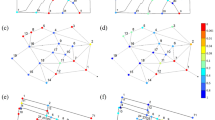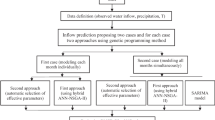Abstract
Water resources allocation problems are mainly categorized in two classes of simulation and optimization. In most cases, optimization problems due to the number of variables, constraints and nonlinear feasible search space are known as a challenging subject in the literature. In this research, by coupling particle swarm optimization (PSO) algorithm and a network flow programming (NFP) based river basin simulation model, a PSO-NFP hybrid structure is constructed for optimum water allocation planning. In the PSO-NFP model, the NFP core roles as the fast inner simulation engine for finding optimum values for a large number of water discharges in the network links (rivers and canals) and nodes (reservoirs and demands) while the heuristic PSO algorithm forms the outer optimization cover to search for the optimum values of reservoirs capacities and their storage priorities. In order to assess the performance of the PSO-NFP model, three hypothetical test problems are defined, and their equivalent nonlinear mathematical programs are developed in LINGO and the results are compared. Finally, the PSO-NFP model is applied in solving a real river basin water allocation problem. Results indicate that the applied method of coupling PSO and NFP has an efficient ability for handling river basin-scale water resources optimization problems.








Similar content being viewed by others
References
Ayvaz MT, Karahan H (2008) A simulation/optimization model for the identification of unknown groundwater well locations and pumping rates. J Hydrol 357:76–92
Bertsekas D, Tseng P, (1994) RELAX-IV: A faster version of the RELAX code for solving minimum cost flow problems, Completion Report for NSF Grant CCR-9103804, Dept. of Electrical Engineering and Computer Science, Massachusetts Institute of Technology, Cambridge
Cheng AHD, Halhal D, Naji A, Ouazar D (2000) Pumping optimization in saltwater-intruded coastal aquifers. Water Resour Res 36:2155–2165
Gaur S, Chahar BR, Graillot D (2011) Analytic elements method and particle swarm optimization based simulation-optimization model for groundwater management. J Hydrol 402:217–227
Huang GH, Loucks DP (2000) An inexact two-stage stochastic programming model for water resources management under uncertainty. Civ Eng Environ Syst 17:95–118
Katsifarakis KL, Petala Z (2006) Combining genetic algorithms and boundary elements to optimize coastal aquifers’ management. J Hydrol 327:200–207
Kennedy J, Eberhart RC (1995) Particle swarm optimization, Proceedings of the IEEE International Joint Conference on Neural Networks, 1942–1948
Labadie J (2005) MODSIM: River basin management decision support system, Chapter 23 in Watershed Models, V. Singh and D. Frevert (eds.), CRC Press, Boca Raton, Florida
Lu HW, Huang GH, He L (2012) Simulation-based inexact rough-interval programming for agricultural irrigation management: a case study in the Yongxin County, China. Water Resour Manage 26:4163–4182
Mantoglou A, Papantoniou M, Giannoulopoulos P (2004) Management of coastal aquifers based on nonlinear optimization and evolutionary algorithms. J Hydrol 297:209–228
Qin XS, Huang GH, He L (2009) Simulation and optimization technologies for petroleum waste management and remediation process control. J Env Manag 90:54–76
Rafiee V, Shourian M (2016) Optimum multicrop-pattern planning by coupling SWAT and the harmony search algorithm. J Irr Drain Eng 142(12):04016063
Rezapour Tabari MM, Soltani J (2013) Multi-objective optimal model for conjunctive use management using SGAs and NSGA-II models. Water Resour Manag 27:37–53
Shourian M, Mousavi SJ, Tahershamsi A (2008) Basin-wide water resources planning by integrating PSO algorithm and MODSIM. Water Resour Manag 22(10):1347–1366
Shourian M, Raoufi Y, Attari J (2017) Interbasin water transfer capacity design by two approaches of simulation-optimization and multicriteria decision making, J Water Resour Plan Manag (ASCE) 143(9):04017054
Singh A (2014) Simulation-optimization modeling for conjunctive water use management. Agric Water Manag 141:23–29
Singh A, Panda SN (2013) Optimization and simulation modelling for managing the problems of water resources. Water Resour Manag 27:3421–3431
Srivastav RK, Srinivasan K, Sudheer KP (2011) Simulation-optimization framework for multi-season hybrid stochastic models. J Hydrol 404:209–225
Yazdi J, Salehi Neyshabouri SAA (2012) A simulation-based optimization model for flood management on a watershed scale. Water Resour Manag 26:4569–4586
Author information
Authors and Affiliations
Corresponding author
Rights and permissions
About this article
Cite this article
Shourian, M., Mousavi, S.J. Performance Assessment of a Coupled Particle Swarm Optimization and Network Flow Programming Model for Optimum Water Allocation. Water Resour Manage 31, 4835–4853 (2017). https://doi.org/10.1007/s11269-017-1781-8
Received:
Accepted:
Published:
Issue Date:
DOI: https://doi.org/10.1007/s11269-017-1781-8




